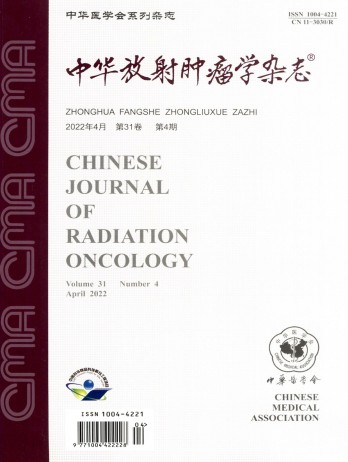48例宫颈残端癌预后不良因素分析
引用次数: 0
摘要
目的探讨影响宫颈残端癌患者预后的因素,为临床诊断和治疗提供一定的参考。方法回顾性分析2005年1月1日至2016年12月1日新疆医科大学附属肿瘤医院收治的48例宫颈残端癌患者的临床资料。ⅠA ~ⅡA期宫颈残端癌19例(40%)采用手术+辅助治疗,ⅡB ~Ⅳ期29例(60%)采用放化疗联合治疗。发病年龄中位数为51岁。子宫肌瘤是子宫次全切除术的主要原因。从子宫次全切除术到确诊的平均时间间隔为10.76年。结果1、3、5年生存率分别为98%、83%、74%。单因素分析显示,子宫次全切除术时间间隔(P=0.016)、肿瘤直径(P=0.016)、临床分期(P=0.036)、组织学分级(P=0.009)、淋巴结转移(P=0.044)、参数性侵(P=0.046)、骨髓抑制(P=0.013)和根治性手术(P=0.019)是影响宫颈残端癌预后的因素。结论宫颈残端癌患者预后不良与肿瘤直径、临床分期、组织学分级、淋巴结转移、参数性侵及骨髓抑制有关。组织学分级是一个独立的危险因素。关键词:宫颈残端;恶性肿瘤/ radiochemotherapy;预后本文章由计算机程序翻译,如有差异,请以英文原文为准。
Analysis of the poor prognostic factors affecting 48 cases of cervical stump carcinoma
Objective
To explore the poor prognostic factors of patients with cervical stump carcinoma, aiming to provide certain reference for the clinical diagnosis and treatment.
Methods
Clinical data of 48 patients with cervical stump carcinoma admitted to the Affiliated Tumor Hospital of Xinjiang Medical University from January 1, 2005 to December 1, 2016 were retrospectively analyzed. A total of 19 patients (40%) withⅠA-ⅡA stage cervical stump carcinoma were treated with surgery+ adjuvant therapy and 29 patients (60%) in ⅡB-Ⅳ stage received radiotherapy combined with chemotherapy. The median age of onset was 51 years old. Uterine fibroids were the main cause of subtotal hysterectomy. The average time interval from subtotal hysterectomy to definite diagnosis was 10.76 years.
Results
The 1-, 3-, 5-year survival rate was 98%, 83% and 74%, respectively. Univariate analysis demonstrated the time interval from subtotal hysterectomy (P=0.016), tumor diameter (P=0.016), clinical stage (P=0.036), histological grade (P=0.009), lymph node metastasis (P=0.044), parametrial invasion (P=0.046), myelosuppression (P=0.013) and radical surgery (P=0.019) were the poor prognostic factors of cervical stump carcinoma.
Conclusions
Poor prognosis of patients with cervical stump carcinoma is correlated with tumor diameter, clinical stage, histological grade, lymph node metastasis, parametrial invasion and myelosuppression. Histological grade is an independent risk factor.
Key words:
Cervical stump; Malignant neoplasm/radiochemotherapy; Prognosis
求助全文
通过发布文献求助,成功后即可免费获取论文全文。
去求助
来源期刊
自引率
0.00%
发文量
6375
期刊介绍:
The Chinese Journal of Radiation Oncology is a national academic journal sponsored by the Chinese Medical Association. It was founded in 1992 and the title was written by Chen Minzhang, the former Minister of Health. Its predecessor was the Chinese Journal of Radiation Oncology, which was founded in 1987. The journal is an authoritative journal in the field of radiation oncology in my country. It focuses on clinical tumor radiotherapy, tumor radiation physics, tumor radiation biology, and thermal therapy. Its main readers are middle and senior clinical doctors and scientific researchers. It is now a monthly journal with a large 16-page format and 80 pages of text. For many years, it has adhered to the principle of combining theory with practice and combining improvement with popularization. It now has columns such as monographs, head and neck tumors (monographs), chest tumors (monographs), abdominal tumors (monographs), physics, technology, biology (monographs), reviews, and investigations and research.

 求助内容:
求助内容: 应助结果提醒方式:
应助结果提醒方式:


